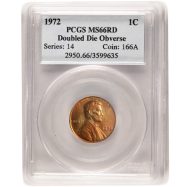Copper Pennies from Provident Metals
For nearly 200 years, the United States Mint issued US Pennies with a large percentage of the metallic alloy consisting of copper. In fact, the earliest pennies issued by the US Mint were as close to 100% copper as possible for the early mint in the 18th century. Today, the US Mint no longer uses more than 2.5% copper in its metallic alloy for pennies, but that doesn’t mean you won’t find copper pennies available to buy as an investment.
History of Copper Pennies
Roughly speaking, there are two ways to split the history of US Pennies. One of these is to look at the weight and copper content of the pennies, while the other option is to look at the so-called Large Cent and Small Cent versions of the penny. These two versions of the penny’s history break its production past apart by the weight and varying copper content of the coins, while the other breaks it down by the standardization of the coin’s size.
Weight and Copper Content History
From 1793 to 1864, the copper content of US pennies varied greatly. During this timeframe, the US penny underwent the following changes in purity and weight:
- 1793-1795: 13.48 Grams and roughly 100% copper
- 1795-1857: 10.89 Grams and roughly 100% copper
- 1857-1864: 5.67 Grams and 88% copper/12% nickel
In 1864, the US Mint established a more stable system for the US penny in terms of its copper content and its overall weight in grams:
- 1864-1942/1944-1982: 3.11 Grams and 95% copper
During this time period, there were several variations to the other alloys in the penny and one special issue during World War II. During the initial timeframe mentioned above, pennies contained a so-called bronze composition of 95% copper with 5% tin and zinc. From 1944-1946, the coins had gilding metal composition of 95% copper with 5% zinc. From 1947-1962, the US Mint switched back to the bronze alloy before switching again to the gilding metal from late 1962 until 1982.
There was a special issue in 1943 that featured no copper. With World War II raging, the United States redirected all copper to industrial use during the conflict. For 1943, the so-called Steel Cent Penny was issued with a steel core coated in zinc.
Large Cent vs Small Cent
When the United States Mint issued the first US pennies, the coins were more commonly referred to as the cent and had a much larger format than today’s penny. From 1793 to 1857, the Large Cent format was issued with the penny featuring a 28.57 MM diameter.
In late 1857, the US Mint resized the US penny and issued the first coins of the modern Small Cent format. It was at this time that the coins became more commonly known as pennies. The new Small Cent is the format still in production today with a diameter of just 19.05 MM.
Brief Design History
In total, there have been 10 designs used on the US penny. The Large Cent series featured far more design variety through the first six decades of production. These included:
- Flowing Hair (Chain reverse): 1793
- Flowing Hair (Wreath reverse): 1793
- Liberty Cap: 1793-1796
- Draped Bust: 1796-1807
- Classic Head: 1808-1814
- Coronet: 1816-1839
- Braided Hair: 1839-1857
With the introduction of the Small Cent format, the US Mint has issued only three broad design programs, with the Lincoln Penny representing the longest-running design in US Mint history and the current US penny design. The Small Cent pennies have featured the following designs:
- Flying Eagle: 1856-1858
- Indian Head: 1859-1909
- Lincoln Cent: 1909-present
Within the Lincoln Cent design series, President Abraham Lincoln has featured on the obverse of the coins. The most popular version of the Lincoln Cent has proven to be the original that was used from 1909-1958. Known as the Wheat Penny, the coin featured Lincoln’s bust on the obverse and wheat stalks flanking the denomination on the reverse. Subsequent designs include the Lincoln Memorial reverse from 1959-2008, a Bicentennial design in 2009 honoring the 200th anniversary of Lincoln’s birth, and the Lincoln Union Shield in use as of 2010.
Buy Copper Pennies at Provident Metals
Provident Metals’ customer service is available to assist you with any questions at 800-313-3315. We are also available to you online through our web chat and email address features.






